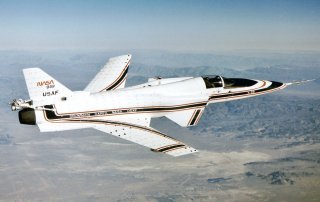Meet the Grumman X-29–an Almost Unnatural Design for a Fighter Jet
One weird plane.
The United States Air Force has developed some truly revolutionary prototype aircraft over the years, including the Bell X-1, which was the first aircraft to break the sound barrier; and the X-5, the first airplane that incorporated variable-sweep wing technology. Those planes almost seem passé when compared to the Grumman X-29, an aircraft that explored some truly cutting-edge design features.
Most notable was that while sweeping wings had become common in the jet age, the X-29 almost looks as if its wings were put on backwards!
Instead of the traditional swept wing, the X-29 featured forward-swept wings, which made it far from an easy plane to fly. The aircraft was not built entirely from the ground up, but rather Grumman produced the two prototypes from a pair of Northrop F-5A Freedom Fighter airframes. The design used the forward fuselage and nose landing gear from the F-5As, while control actuators and main landing gear from an F-16.
The concept wasn’t entirely new, as the United States and Nazi Germany had experimented with forward-swept wings during World War II and each had encountered problems—notably metal wings could bend dangerously, especially at higher speeds.
The X-29, which was developed by the United States Air Force and the Defense Advanced Research Projects Agency (DARPA), solved the problem by the use of advanced composite materials, which made the wing structures both lightweight and very rigid. Along with a forward-mounted elevator (or canard) the X-29 proved agile even at high speeds yet it came with aerodynamic instability—which required a computerized fly-by-wire control system to aid the pilot in flight.
Without the digital flight computer, which made corrections to the flight path about forty times per second, the advanced-looking aircraft would be all but unflyable. More worrisome for any pilot who took up the X-29 was that if all three of the flight computers failed, the aircraft could have broken up even before the pilot had a chance to eject!
The two prototypes were flown a total of 437 times between 1984 and 1992, and in December 1985 one of the aircraft became the first forward-swept wing aircraft in the world to exceed Mach 1 in level flight. That test mission highlighted how highly unstable aircraft with forward-swept wings could be flown safely and offer excellent maneuverability and high G-loads.
More importantly the flight research conducted during those test flights added greatly to engineers’ understanding of advanced composites and digital flight control systems—both of which are increasingly common in jet aircraft construction.
The X-29 wasn’t the last aircraft to feature such a radical design. Some five years after the final X-29 mission, in September 1997, the Russian Air Force flew its Sukoi Su-47, which also featured forward-swept wings. It had been the result of a project launched by the Soviet Air Force in the 1980s, but delayed due to the dissolution of the Soviet Union. The Russian aircraft was almost twice as large as the X-29, but as with the American design never went beyond the prototype stage.
Today the two American X-29 aircraft are on display—one in the Research and Development Gallery at the National Museum of the United States Air Force in Dayton, Ohio; and the other at the Armstrong flight Research Center at Edwards Air Force Base in California. A full-scale model was also on display until 2011 at the National Air and Space Museum in Washington, D.C.
Peter Suciu is a Michigan-based writer who has contributed to more than four dozen magazines, newspapers and websites. He is the author of several books on military headgear including A Gallery of Military Headdress, which is available on Amazon.com.
Image: Wikimedia

